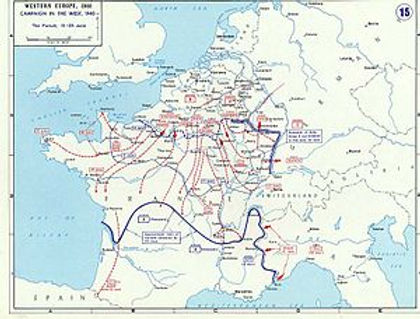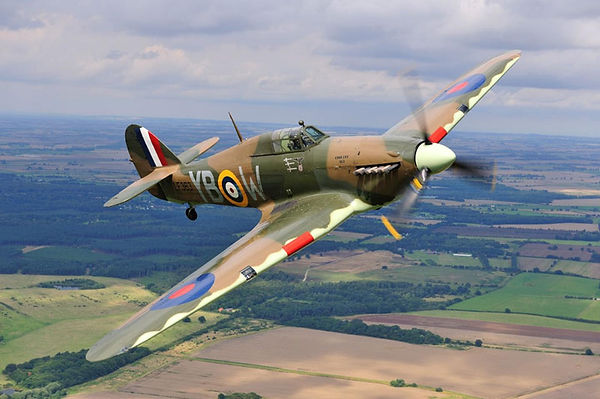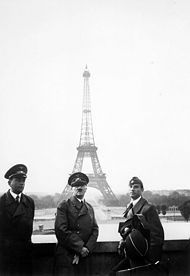Dunkirk
In the early hours of May 23 Gort ordered a retreat from Arras. By now he had no faith in the Weygand plan, or in Weygand's proposal to at least try to hold a pocket on the Flemish coast, a so-called Réduit de Flandres. Gort knew that the ports needed to supply such a foothold were already being threatened. That same day the 2nd Panzer Division had assaulted Boulogne. The British garrison in Boulogne surrendered on 25 May, although 4,368 troops were evacuated. This British decision to withdraw was much criticized by later French publications.
The 10th Panzer Division attacked Calais, beginning on May 24. British reinforcements (3rd Royal Tank Regiment, equipped with cruiser tanks, and the 30th Motor Brigade) had been hastily landed 24 hours before the Germans attacked. The Siege of Calais lasted for four days. The British defenders were finally overwhelmed and surrendered at approximately 16:00 on May 26 while the last French troops were evacuated in the early hours of May 27.

The German offensive in June sealed the defeat of the French.

British and French troops waiting to be evacuated at Dunkirk
The 1st Panzer Division was ready to attack Dunkirk on May 25, but Hitler ordered it to halt the day before. This remains as one of the most controversial decisions of the entire war. Hermann Göring had convinced Hitler that the Luftwaffe could prevent an evacuation and von Rundstedt warned him that any further effort by the armoured divisions would lead to a much longer refitting period. Also attacking cities was not part of the normal task for armoured units under the German operational doctrine.
Encircled, the British, Belgian and French forces launched Operation Dynamo which evacuated Allied troops from the northern pocket in Belgium and Pas-de-Calais, beginning on May 26. About 198,000 British soldiers were evacuated in Dynamo, along with nearly 140,000 French soldiers; almost all of which later returned to France. The Allied position was complicated by Belgian King Léopold III's surrender the following day, which was postponed until May 28.
During the Dunkirk battle the Luftwaffe flew 1,882 bombing and 1,997 fighter sweeps. British losses totalled 6 percent of their total losses during the French campaign, including 60 precious fighter pilots. However, the Luftwaffe failed in its task of preventing the evacuation, but had inflicted serious losses on the Allied forces. A total of 89 merchantmen (of 126,518 grt) were lost; the Royal Navy lost 29 of its 40 destroyers sunk or seriously damaged.
As early on as the May 16, the French positions on the ground and in the air have become desperate. They pressed the British to commit more of the RAF fighter groups to the battle. Hugh Dowding, C-in-C of RAF Fighter Command refused, arguing that if France collapsed, the British fighter force would be severely weakened. The RAF force of 1078 had been reduced to just 475 aircraft. RAF records show just 179 Hawker Hurricanes and 205 Supermarine Spitfires were serviceable on June 5, 1940.


British Spitfire(Top) and Hawker Hurricanes(Right)
Confusion still reigned. After the evacuation at Dunkirk and while Paris was enduring a short-lived siege, part of the 1st Canadian Infantry Division was sent to Brittany (Brest) and moved 320 kilometres (200 mi) inland toward Paris before they heard that Paris had fallen and France had capitulated. They retreated and re-embarked for England. Also the British 1st Armoured Division under General Evans (without its infantry, which had been re-assigned to keep the pressure off the BEF at Dunkirk) had arrived in France in June 1940 and was then joined by the former labour battalion of the 51st (Highland) Division and was forced to fight a rear-guard action. Other British battalions were later landed at Cherbourg and were still waiting to form a second BEF.
At the end of the campaign Erwin Rommel praised the staunch resistance of British forces, despite being under-equipped and without ammunition for much of the fighting.
French problems
The best and most modern French armies had been sent north and lost in the resulting encirclement; the French had lost much of their heavy weaponry and their best armoured formations. Weygand was faced with the prospect of defending a long front (stretching from Sedan to the Channel), with a greatly depleted French Army now lacking significant allied support. Sixty divisions were required to man the 600 kilometre (400 mi) long frontline, Weygand had only 64 French and one remaining British division (the 51st Highland Division) available. Therefore, unlike the Germans, he had no significant reserves to counter a breakthrough or to replace frontline troops, should they become exhausted from a prolonged battle. Should the frontline be pushed further south, it would inevitably get too long for the French to man it. Some elements of the French leadership had openly lost heart, particularly as the British were evacuating. The Dunkirk evacuation was a blow to French morale because it was seen as an act of abandonment.

German troops in Paris

British Bristol Bleinheim
The Germans renewed their offensive on June 5 on the Somme. An attack broke the scarce reserves that Weygand had put between the Germans and the capital, and on June 10 the French government fled to Bordeaux, declaring Paris an open city.
Winston Churchill returned to France on June 11 and met the French War Council in Briare. The French requested that Churchill supply all available fighter squadrons to aid in the battle. With only 25 squadrons remaining, Churchill refused, believing at this point that an upcoming Battle of Britain would be decisive in the war.
At the meeting, Churchill obtained assurances from French admiral François Darlan that the fleet would not fall into German hands. On June 14 Paris, the capture of which had so eluded the German Army in World War I (First Battle of the Marne), fell to the Wehrmacht. This marked the second time in a century that Paris had been captured by German forces (the former occurred during the 1870-1871 Franco-Prussian War).
By this date the situation in the air had now grown critical. The Luftwaffe established air supremacy (as opposed to air superiority) as the French air arm was on the verge of collapse. The French Air Force (Armee de l'Air) had only just begun to make the lion's share of bomber sorties, and between June 5 and June 9, over 1,815 missions, of which 518 were bomber sorties, were flown. However, the number of sorties flown declined as losses were now becoming impossible to replace. The British Royal Air Force (RAF) attempted to divert the attention of the Luftwaffe with 660 sorties flown against targets over the Dunkirk area but losses were heavy; on June 21 alone 37 Bristol Blenheims were lost. After June 9, French aerial resistance virtually ceased and some surviving aircraft withdrew to French North Africa. The Luftwaffe now "ran riot." Its attacks were focused on direct and indirect support of the German Army (Wehrmacht Heer).The Luftwaffe subjected lines of resistance to ferocious assault, which then quickly collapsed under armoured attack.
The Luftwaffe virtually destroyed the Armée de l'Air during the campaign and inflicted heavy losses to the RAF contingent that was deployed. It is estimated the French lost 1,274 aircraft destroyed during the campaign, the British suffered losses of 959 (477 fighters).The battle for France had cost the Luftwaffe 28 percent of its front line strength, some 1,428 aircraft destroyed. A further 488 were damaged, making a total of 36 percent of the Luftwaffe strength negatively affected. The campaign had been a spectacular success for the German air-arm. The Luftwaffe had effectively destroyed three Allied air forces and inflicted heavy losses to a fourth.



(In order) The Belgium, French and Royal Netherlands air force were almost completely wiped out by the end of 1941.
Most of the remaining British troops in the field had arrived at Saint-Valery-en-Caux for evacuation, but the Germans took the heights around the harbor making this impossible and on June 12 General Fortune and the remaining British forces surrendered to Rommel. The evacuation of the second BEF took place during Operation Ariel between June 15 and June 25. The Luftwaffe, with complete mastery of the French skies, was determined to prevent more Allied evacuations after the Dunkirk debacle. Fliegerkorps I was assigned to the Normandy and Brittany. On 9/10 June the port of Cherbourg was subject to 15 tons of German bombs, while Le Havre received ten bombing attacks which sank 2,949 grt of escaping Allied shipping. On June 17, 1940 Junkers Ju 88s (mainly from Kampfgeschwader 30) destroyed a "10,000-ton ship" which was the 16,243 grt Lancastria off St. Nazaire, killing some 5,800 Allied personnel. Nevertheless, the Luftwaffe failed to prevent the mass evacuation of some 190.000 - 200,000 Allied personnel.
Surrender and Armistice
Hitler (hand on side) staring at Foch's statue before signing the armistice at Compiègne, France (June 22, 1940)
Prime Minister Paul Reynaud was forced to resign because he refused to agree to end the war. He was succeeded by Marshal Philippe Pétain, who delivered a radio address to the French people announcing his intention to ask for an armistice with Germany. When Hitler received word from the French government that they wished to negotiate an armistice, he selected the Compiègne Forest as the site for the negotiations. As Compiègne had been the site of the 1918 Armistice, which had ended World War I with a humiliating defeat for Germany, Hitler viewed the choice of location as a supreme moment of revenge for Germany over France. The armistice was signed on June 22 in the very same railway carriage in which the 1918 Armistice was signed (removed from a museum building and placed on the precise spot where it was located in 1918), Hitler sat in the same chair in which Marshal Ferdinand Foch had sat when he faced the defeated German representatives. After listening to the reading of the preamble, Hitler, in a calculated gesture of disdain to the French delegates, left the carriage, leaving the negotiations to his OKW Chief, General Wilhelm Keitel. The French Second Army Group, under the command of General Pretelat, surrendered the same day as the armistice and the cease-fire went into effect on June 25, 1940.
Aftermath
Adolf Hitler in Paris, June 23, 1940.
France was divided into a German occupation zone in the north and west and a nominally independent state in the south, to be based in the spa town of Vichy, dubbed Vichy France. The new French state, headed by Pétain, accepted its status as a defeated nation and attempted to buy favour with the Germans through accommodation and passivity. Charles de Gaulle, who had been made an Undersecretary of National Defence by Reynaud, in London at the time of the surrender, made his Appeal of 18 June. In this broadcast he refused to recognize the Vichy government as legitimate and began the task of organizing the Free French forces. Numerous French colonies abroad (French Guiana, French Equatorial Africa) joined de Gaulle rather than the Vichy government.
The British began to doubt Admiral Darlan's promise to Churchill not to allow the French fleet at Toulon to fall into German hands by the wording of the armistice conditions; they therefore attacked French naval forces in Africa and Europe, which led to feelings of animosity and mistrust between the former French and British allies.

